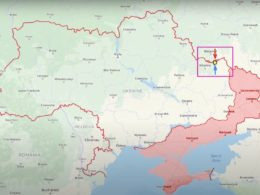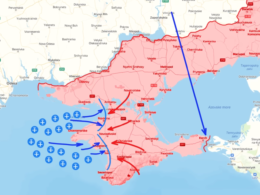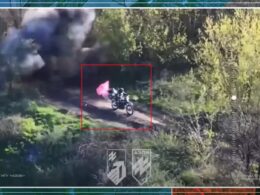Day 763: 27 March
On 27 March, there are a lot of updates from the Lyman direction. Here, Russians have been continuously assaulting Ukrainian positions in an attempt to reach the Ukrainian settlements along the Zherebets River.
The main goal of the Russians is to take control of the Ukrainian city and logistics hub of Lyman.

However, the Russians realized this would be far more difficult than expected, as they first had to cross the heavily defended Zherebets River, over which Ukrainians established a strong logistics network that allowed them to fend off most Russian assaults.
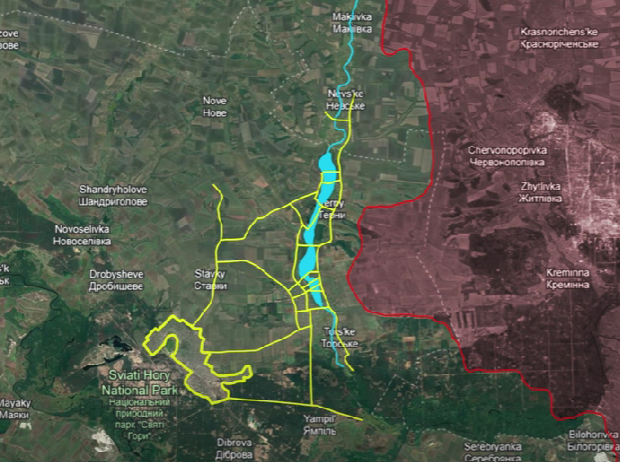
Furthermore, any Russian assaults that threaten to overwhelm Ukrainian defenders are then quickly counterattacked by quick-reaction forces or Ukrainian soldiers from the forest, making it an intense but even battle.
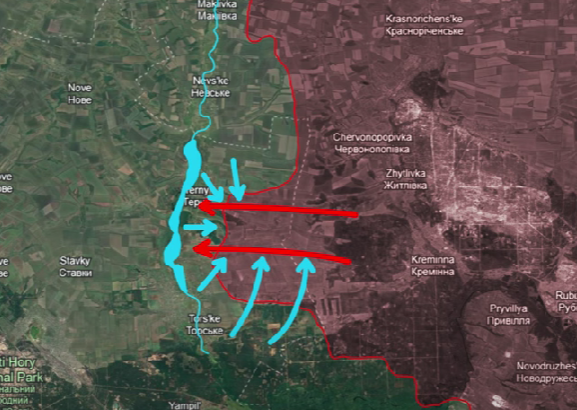
As you may remember, the last Russian mechanized assault waves ended in complete disaster for the Russians. They did not manage to come even close to the settlements and were destroyed already on the approach.
To adapt their strategy to the current situation, Russian forces now use their armor to transport infantry as close to the forest as possible and drop the infantry off, who then carry out the assault themselves while the armored vehicle quickly retreats.
These infantry groups then move through the tree lines and take concealed positions in the forest to accumulate forces to launch large-scale infantry assaults. However, for such assaults to succeed without armored support, Russians need to rely on intensive artillery bombardments to undermine Ukrainian positions and prepare for the assaults.
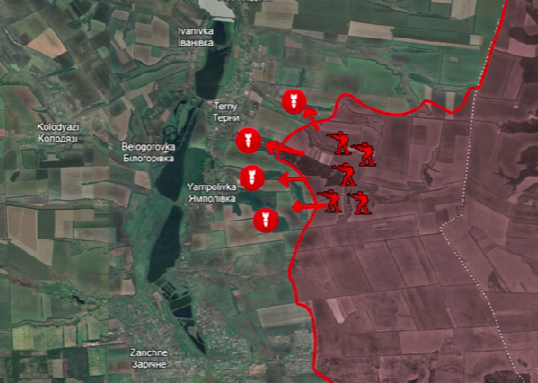
Ukrainians understood the Russian predicament and decided to take immediate pre-emptive action. They used FPV drones and precision artillery to perform counter-battery fire on Russians when they opened fire on Ukrainian positions.
Geolocated footage also shows that the Ukrainian 45th Artillery Brigade successfully destroyed a Russian heavy mortar Tulip, two D-20 howitzers, and two D-30 howitzers, all in one operation.
The Ukrainian 45th Artillery Brigade also worked together with drone operators from the 63rd Mechanized Brigade to destroy another Russian heavy mortar Tulip, an artillery munition depot, a D-20 howitzer, and three more D-20 howitzers the day before.
The Ukrainian 63rd brigade also destroyed a heavy mortar Tulip on their own with an FPV kamikaze drone.
The Ukrainian Predator drone detachment from the border police also performed two successful hits on Russian artillery, destroying one heavy mortar Tulip and one multiple-launch rocket system Grad with FPV kamikaze drones.
The large number of Russian Tulip heavy mortar systems, which use heavy shells to undermine defensive positions, shows that Russians are primarily focused on destroying the Ukrainian fortifications before moving in with their infantry. Ukrainian forces did not stop there.

And while their artillery crews were busy destroying any Russian artillery in the region that dared to open fire, Ukrainian drone operators aimed to destroy any Russian vehicle trying to cross the fields between Kreminna and the settlements along the river.
Geolocated footage shows Ukrainian drone operators from the 23rd Rifle Battalion destroying an assault group consisting of two tanks and two infantry fighting vehicles with FPV kamikaze drones.
The Ukrainian 60th mechanized brigade also destroyed two Russian armored personnel carriers with mines, three more with FPV drones, and a T-72 tank with an FPV kamikaze drone.
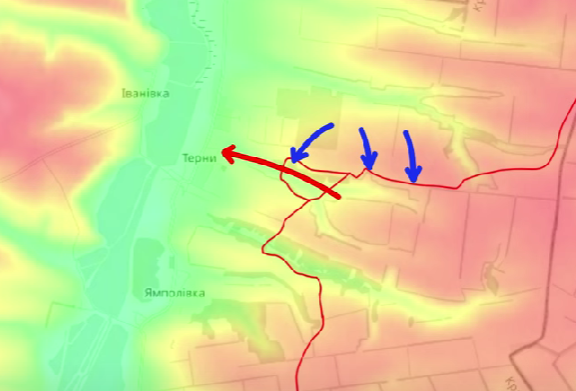
Drone operators from the 63rd mechanized brigade were also heavily active in the area, destroying two armored personnel carriers and one infantry fighting vehicle with kamikaze drones.
Ukrainian drone operators from the 100th Territorial Defense Brigade and 12th Special Purpose Brigade were also operating from the forest and destroyed two Russian transport trucks, an armored car Tiger, which is a Russian version of the Humvee, and an infantry fighting vehicle along the road to Torske with FPVs.
Despite the intensity of drone operations, Russians still managed to accumulate themselves in the forests. However, the attacks of these understrength Russian Assault Groups were doomed to be suicidal because they suffered from a critical lack of reinforcements and armored artillery support. At the same time, Ukrainians counterattacked them with their infantry fighting vehicles, artillery, and drone-dropped munitions.
Eventually, after three weeks of heavy fighting in the area and enormous Russian casualties, Russian forces barely managed to take control of the forest in the northern valley east of Terny, giving Russians partial control over the hill in between.
However, let's look at the topographic map. We can see that any Russian attack from this forest towards Terny would be vulnerable to a Ukrainian flank attack from the hill above.
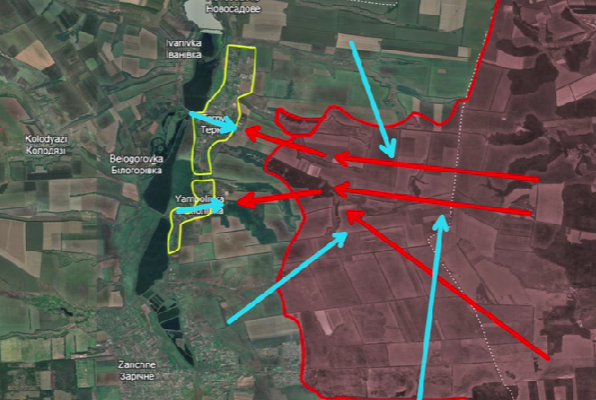
As such, the only real tactical gain for Russians over these last three weeks has been slightly securing the flank of the largest forest in front of the settlement, of which Russians still only control half.
A Russian military blogger stated that while Ukrainians still control the settlements themselves, Russian forces now hold the initiative to perform simultaneous attacks on both Terny and Yampolivka in the near future.
However, such an assault would have to cover a vast amount of open fields, which are tightly visually controlled by Ukrainian drone operators, allowing Ukrainians to be well-prepared for an attack and possibly intercept the convoy long before they reach the contact line.

Moreover, any large infantry assault from the forests is subject to Ukrainian fire and counterattacks from nearly all sides.
Overall, the intense Ukrainian counter-battery fire, jointly with combined drone operations and strong positional fighting, completely drained the Russian assault groups of their offensive capabilities, preventing Russians from forcing a breakthrough toward the settlements.
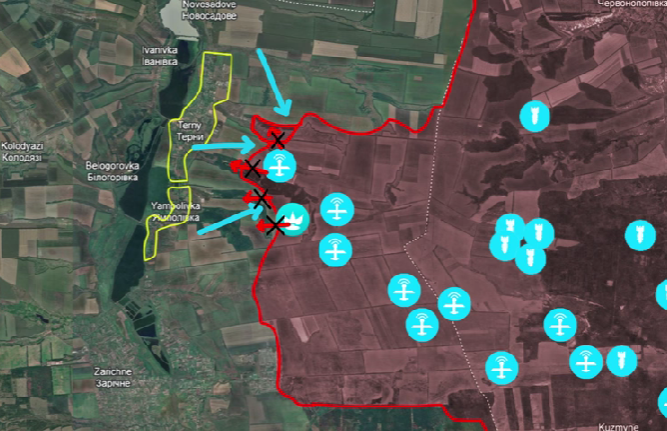
If Ukrainians manage to maintain the intensity of counter-battery fire and drone attacks, Russian forces will not be able to build up a sufficient amount of force or momentum to break Ukrainian lines further and reach the settlements.
In our daily frontline report
, we pair up with the military blogger Reporting from Ukraine to keep you informed about what is happening on the battlefield in the Russo-Ukrainian war.


